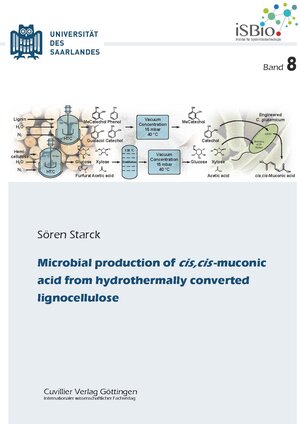Microbial production of cis,cis-muconic acid from hydrothermally converted lignocellulose
von Sören StarckCis, cis-muconic acid receives increasing interest to be produced from renewables. Catabolic microbial pathways can be tailored to accumulate cis, cis-muconic acid from a range of aromatic compounds. A renewable, sustainable and under-valued resource for aromatics is lignin. In this work, using hydrothermal conversion, lignin was depolymerized into hydrolysates with up to 615 mM aromatic monomer content. Catechol-rich hydrolysates were generated for bioconversion with the previously developed cis, cis-muconic acid producers P. putida MA-9 and C. glutamicum MA-2, whereas hydrolysates were guaiacol-rich for Amycolatopsis sp. MA-2. When grown with glucose as a co-substrate, C. glutamicum MA-2 yielded 2.6 g L⁻¹ (100 % yield) cis, cis-muconic acid from catechol. Towards an even more sustainable process, glucose was then replaced by hemicellulose, a non-food renewable. Hemicellulose, a co-constituent of lignin in lignocellulose, was hydrothermally converted into a mixture of C₅ and C₆ sugars. As hemicellulose was mainly converted into xylose (91 % yield), C. glutamicum MA-2 was engineered to utilize this pentose. Fed-batch bioconversion on a catechol-rich Kraft lignin hydrolysate as well as a hemicellulose hydrolysate using C. glutamicum MA-4 yielded 4 g L⁻¹ muconic acids. As the developed process was non-competitive to feed and food, it is a promising starting point for future application in bio-based industrial settings.







